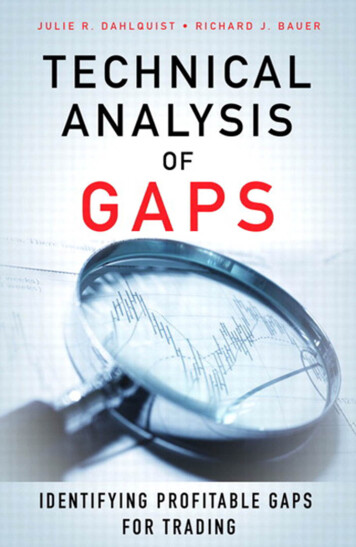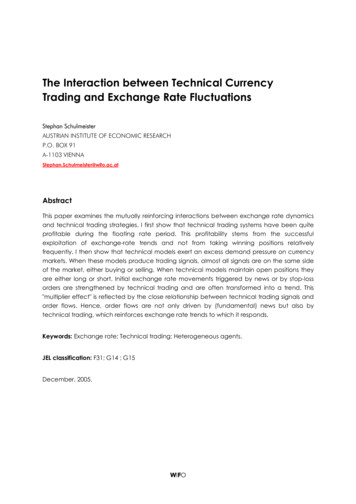
Transcription
TECHNICALANALYSISOF GAPS
This page intentionally left blank
TECHNICALANALYSISOF GAPSIDENTIFYING PROFITABLEGAPS FOR TRADINGJULIE R. DAHLQUISTRICHARD J. BAUER, JR.
Vice President, Publisher: Tim MooreAssociate Publisher and Director of Marketing: Amy NeidlingerExecutive Editor: Jim BoydEditorial Assistant: Pamela BolandOperations Specialist: Jodi KemperAssistant Marketing Manager: Megan GraueCover Designer: Alan ClementsManaging Editor: Kristy HartSenior Project Editor: Lori LyonsCopy Editor: Apostrophe Editing ServicesProofreader: Kathy RuizIndexer: Lisa StumpfCompositor: Nonie RatcliffManufacturing Buyer: Dan Uhrig 2012 by Julie R. Dahlquist / Richard J. Bauer, Jr.Pearson Education, Inc.Publishing as FT PressUpper Saddle River, New Jersey 07458This book is sold with the understanding that neither the author nor the publisher isengaged in rendering legal, accounting, or other professional services or advice bypublishing this book. Each individual situation is unique. Thus, if legal or financialadvice or other expert assistance is required in a specific situation, the services of acompetent professional should be sought to ensure that the situation has been evaluated carefully and appropriately. The author and the publisher disclaim any liability,loss, or risk resulting directly or indirectly, from the use or application of any of thecontents of this book.FT Press offers excellent discounts on this book when ordered in quantity for bulkpurchases or special sales. For more information, please contact U.S. Corporate andGovernment Sales, 1-800-382-3419, corpsales@pearsontechgroup.com. For sales outside the U.S., please contact International Sales at international@pearson.com.Stock charts created with TradeStation. TradeStation Technologies, Inc. All rightsreserved.Company and product names mentioned herein are the trademarks or registeredtrademarks of their respective owners.All rights reserved. No part of this book may be reproduced, in any form or by anymeans, without permission in writing from the publisher.Printed in the United States of AmericaFirst Printing June 2012ISBN-10: 0-13-290043-2ISBN-13: 978-0-13-290043-0Pearson Education LTD.Pearson Education Australia PTY, Limited.Pearson Education Singapore, Pte. Ltd.Pearson Education Asia, Ltd.Pearson Education Canada, Ltd.Pearson Educación de Mexico, S.A. de C.V.Pearson Education—JapanPearson Education Malaysia, Pte. Ltd.Library of Congress Cataloging-in-Publication DataDahlquist, Julie R., 1962Technical analysis of gaps : identifying profitable gaps for trading / Julie R.Dahlquist, Richard J. Bauer, Jr.p. cm.ISBN 978-0-13-290043-0 (hbk. : alk. paper)1. Stocks—Charts, diagrams, etc. 2. Technical analysis (Investment analysis) I.Bauer, Richard J., 1950- II. Title.HG4638.D34 2012332.63’2042—dc232012010828
To Katherine and Sepp
This page intentionally left blank
ContentsAbout the Authors . . . . . . . . . . . . . . . . . . . . . . . . . xiiChapter 1: What Are Gaps? . . . . . . . . . . . . . . . . . . . 1Chapter 2: Windows on Candlestick Charts . . . . . . 17Chapter 3: The Occurrence of Gaps . . . . . . . . . . . . 43Chapter 4: How to Measure Returns . . . . . . . . . . . 71Chapter 5: Gaps and Previous Price Movement . . 107Chapter 6: Gaps and Volume . . . . . . . . . . . . . . . . 121Chapter 7: Gaps and Moving Averages. . . . . . . . . 139Chapter 8: Gaps and the Market . . . . . . . . . . . . . 159Chapter 9: Closing the Gap . . . . . . . . . . . . . . . . . 205Chapter 10: Putting It All Together . . . . . . . . . . . 219Index . . . . . . . . . . . . . . . . . . . . . . . . . . . . . . . . . . 227
AcknowledgmentsWe first started looking at gaps because theyprovide useful illustrations when teachingour students how to read stock charts.Students hear a news report that their favorite companyjust reported earnings, that a company is being sued, orthat a well-known company, such as Apple, is launching a new product and ask how these events will affectthe price of the stock of the company. These newsevents often trigger sizeable price moves, frequently ona gap. We can introduce the concept of a gap easily andquickly and then use the conversation as a jumping-offpoint for broader discussion of the tools of technicalanalysis.Gaps repeatedly come up during small talk whenpeople find out that we have a background in technicalanalysis. Even individuals who know little about thestock market seem to have heard the adage “the gap isalways filled.” The two technical analysis terms thatpeople seem to latch on to are “head and shoulders”and “gaps.” After engaging in a number of these conversations, we thought it would be interesting to pursuethis topic a bit more. Gaps seem to have captured theattention of the earliest technical analysts, but we foundsurprisingly little systematic study of gaps. Much of therecent work in the area of technical analysis has beenbased on complex mathematical models. We thought itwould be a fun and interesting endeavor to investigateone of the simple, basic ideas of technical analysis inmore depth. Thus, a couple of years ago we began ourinquiry.
AcknowledgmentsixIn the beginning, we thought we would engage in asimple study that would provide some interesting storiesregarding gaps to use in our classrooms. As we startedlooking at gaps, our appreciation for their use as a toolof technical analysis grew and our inquiry grew. In May2011, we were honored as recipients of the MarketTechnicians Association’s Charles H. Dow Award inTechnical Analysis for our paper, “Analyzing Gaps forProfitable Trading Strategies.” We realized that in ourpaper we had only been able to scratch the surface ofgaps. Our editor, Jim Boyd, suggested we continue ourinvestigation in the form of a book—the result of whichyou are holding in your hands.We are indebted to a number of people who helpedus learn more about gaps and who helped put thisknowledge together in the form of this book. First, weare indebted to Charlie Kirkpatrick for all the supportand assistance he has given us in learning about technical analysis over the years. His knowledge and patienceare endless. Ellie Kirkpatrick, Charlie’s wife, is thegreatest cheerleader anyone could have in their corner.She continues to motivate and inspire us. We thank bothCharlie and Ellie for the endless list of things that theyhave done for us and our children.We would like to thank Fred Meissner and HankPruden for their support and encouragement. They areboth stellar examples of the friendliness and warmthexhibited by many in the technical analysis community.They, too, have been especially kind to our children.Thanks to all those who work in the MTA office, especially Tom Silveri, Tim Licitra, and Shane Skwarek. Thisproject has benefited from conversations with membersof the MTA through electronic discussion groups, webinars, and meetings across the world—from Houston to
xTechnical Analysis of GapsPrague. A special thanks to Robert Colby and RalphAcampora for answering questions along the way.Thanks, also, to Norgate Investor Services for grantingus permission to publish our results, which were basedon their stock price data marketed as Premium Data.We are grateful to the Pearson staff, especially executive editor Jim Boyd, managing editor Kristy Hart, andsenior project editor Lori Lyons for their hard work anddedication in bringing this project to fruition.We have dedicated this book to our children,Katherine and Sepp. They challenge, inspire, and entertain us in innumerable ways. It is bittersweet watchingour children grow up. We miss their younger versions,but our relationship with them both deepens andbecomes more meaningful and special with each passingyear. We feel richly blessed with the honor of being theirparents.—Julie and RichardBeing able to undertake a project like this requiresthe encouragement and support of family, teachers,friends, and colleagues over a number of years. Thanksto my mom for encouraging me to pursue studies in economics and finance, although she claims not to understand anything about it herself. Thanks to my sisters,Carrie and Katie, for being there to laugh about oldfamily stories whenever I need a break from work.Good luck to my nephew, John, as he embarks upon hiscollege career!—Julie
AcknowledgmentsxiI want to thank family members for their support. Ithank my father, Dick Bauer, for his continued love andencouragement. He has also given me an appreciationfor dedication, perseverance, and striving for excellence.I also thank Amy and Mary for their ongoing love andsupport. I look forward to seeing the paths taken byJake, Sophia, Joshua, Grant, and Lucy; they haveincredible parents. Thanks to Don, Ruth, and Brendafor all of their encouraging words.—Richard
About the AuthorsJulie R. Dahlquist, Ph.D., CMT is a senior lecturer,Department of Finance, at the University of Texas atSan Antonio College of Business. She is the recipient ofthe 2011 Charles H. Dow Award for excellence and creativity in technical analysis. She is the coauthor (withCharles Kirkpatrick) of Technical Analysis: TheComplete Resource for Financial Market Techniciansand coauthor (with Richard Bauer) of Technical MarketIndicators: Analysis and Performance. Her research hasappeared in a number of publications, includingFinancial Analysts Journal, Journal of TechnicalAnalysis, Active Trader, Working Money, ManagerialFinance, Financial Practices and Education, and theJournal of Financial Education. She serves on the boardof the Market Technicians Association EducationalFoundation and is a frequent presenter at national andinternational conferences. She earned her B.B.A. andPh.D. in economics from University of Louisiana atMonroe and Texas A&M, respectively, and her M.A. inTheology from St. Mary’s University.Richard J. Bauer, Jr., Ph.D., CFA, CMT is Professor ofFinance at the Bill Greehey School of Business at St.Mary’s University in San Antonio, Texas. His degreesinclude a B.S. in Physics, M.S. in Physics, M.S. inEconomics, and a Ph.D. in Finance. He is the author ofGenetic Algorithms and Investment Strategies andTechnical Market Indicators (with J. Dahlquist), bothpublished by John Wiley and Sons. He is the recipient
About the Authorsxiiiof the 2011 Charles H. Dow Award for excellence andcreativity in technical analysis. His research hasappeared in a number of publications, includingFinancial Analysts Journal Journal of BusinessResearch, Managerial Finance, and Korean FinancialManagement Journal. He became a CFA charterholderin 1990 and a CMT charterholder in 2010. He is a pastpresident of the CFA Society of San Antonio.
This page intentionally left blank
Chapter 1What Are Gaps?Gaps have attracted the attention of market technicians since the earliest days of stock charting.A gap occurs when a security’s price jumpsbetween two trading periods, skipping over certainprices. A gap creates a hole, or a void, on a price chart.Because technical analysis has traditionally been anextremely visual practice, it is easy to understand whyearly technicians noticed gaps. Gaps are visually conspicuous on a price chart. Consider, for example, thestock chart for Huntington Bancshares (HBAN) inFigure 1.1. A quick glance at the price activity revealsfour gaps.1
2Technical Analysis of GapsCreated with TradeStationFIGURE 1.1Gaps on stock chart for HBAN September 29–December 2, 2011
What Are Gaps?3In Figure 1.1, Gap A and Gap C are known as a gapdown. A gap down occurs when one day’s high is lowerthan the previous day’s low. In the figure you can seethat the lowest price for HBAN on September 19 was 5.20. On September 20, the highest price at whichHBAN traded was 5.01. Thus, a gap of 19 cents wasformed. From September 19 through September 20,HBAN traded for 5.20 and higher and for 5.01 andlower; however, no shares traded hands at a pricebetween 5.01 and 5.20. Thus, a void or gap in pricewas formed.Just as a security’s price can gap down, it can gap up.A gap up occurs when one day’s low is greater than theprevious day’s high. Both Gaps B and D in Figure 1.1represent gap ups.Early technicians did not pay attention to gaps simply because they were conspicuous and easy to spot ona stock chart. Because gaps show that a price hasjumped, they may represent some significant change inwhat is happening with the stock and present a tradingopportunity.A technical analyst watches stock price behavior,searching for signs of any change in behavior. If a stockis in a strong uptrend, the analyst watches for any signthat the trend has ended. When a stock is in a consolidation period, the analyst watches for any sign of achange in behavior that would indicate a breakouteither to the upside or to the downside. Spotting thesechanges leads to profitable trading, allowing the traderto jump on a trend, ride the trend, and exit once thetrend has ended. Gaps can be one indication of animpending change in trend.
4Technical Analysis of GapsGiven the persistence of superstitions, such as “a gapmust be closed,” surprisingly little study has beenundertaken to analyze the effectiveness of using gaps intrading. This book provides a comprehensive study ofgaps in an attempt to isolate gaps which present profitable trading strategies.Types of GapsGap types differ based on the context in which theyoccur. Some price gaps are meaningful, and others canbe disregarded.Breakaway (or Breakout) GapsA breakaway gap is one that occurs at the beginning ofa trend (see Figure 1.2). In November 2006, AT&T (T)was in a trading range. On November 29, the stockgapped up and an uptrend began. Because profits aremade by jumping on and riding a trend, breakawaygaps are considered the most profitable gaps for tradingpurposes.Runaway (or Measuring) GapsA gap that occurs along a trend line is called a runawaygap or a measuring gap. Often, a runaway gap appearsin a strong trend that has few minor corrections. Thecontrast between a breakaway gap and a runaway gapis highlighted in Figure 1.3. In July 2006, Apple (AAPL)experienced a breakaway gap, with price jumping from 55 to 60 a share, and an uptrend began. The stockprice headed higher over the next 3 months. Then, onOctober 19, the stock gapped up again by several dollars; the uptrend continued.
Breakaway gap on stock chart for T, November 13–December 14, 2006What Are Gaps?Created with TradeStationFIGURE 1.25
6Technical Analysis of GapsRunaway gaps are often referred to as measuringgaps because of their tendency to occur at about themiddle of a price run. Indeed, this is what AAPL did inFigure 1.3. Thus, the distance from the beginning of thetrend to the runaway gap can be projected above thegap to obtain a target price. Bulkowski (2010) findsthat an upward runaway gap occurs, on average, 43%of the distance from the beginning of the trend to theeventual peak, and a downward gap occurs, on average,at 57% of the distance.Exhaustion GapsAs its name sounds, an exhaustion gap occurs at the endof a trend. In the case of an uptrend, price makes onelast attempt to move higher on a last gasp of breath;however, the trend is exhausted, and the higher pricecannot be sustained. For example, the gap up onJanuary 9, 2007 (refer to Figure 1.3) occurs as AAPL’spowerful uptrend is coming to an end. It is easy todetect an exhaustion gap in hindsight; however, distinguishing an exhaustion gap from a runaway gap at thetime of the gap can be difficult because the two sharemany characteristics.Popular wisdom suggests that trading exhaustiongaps can be dangerous. An exhaustion gap signals theend of a trend. However, one of two things can happen;the trend may reverse immediately, or price may remainin a congestion area for some time. An exhaustion gapsignals a trader to exit a position but does not necessarily signal the beginning of a new trend in the oppositeposition.
FIGURE 1.3Runaway gap on stock chart for AAPL, June 23, 2006–January 24, 2007What Are Gaps?Created with TradeStation7
8Technical Analysis of GapsOther GapsIn addition to breakaway, runaway, and exhaustiongaps, technical analysts identify a few types of gaps thatare generally of no consequence for a trader. Commongaps occur in illiquid trading vehicles, are small in relation to the price of the vehicle, or appear in short-termtrading data. An ex-dividend gap may occur in a stockprice when a dividend is paid and the stock price isadjusted the following day. Ex-dividend gaps areinsignificant, and the trader must be careful not to misinterpret them. Suspension gaps can occur in 24-hourfutures trading when one market closes and anotheropens, especially if one market is electronic and theother is open outcry; these are also insignificant.An opening gap occurs when the opening price forthe day is outside the previous day’s range. After theopening, price might continue to move in the directionof the gap, forming a gap for the day. Or the price mightretrace, closing the gap. Figure 1.4 shows three openinggaps for McDonald’s (MCD). See how, on December 2,MCD opened at a price higher than the December 1price range. However, the price moved lower during theday, filling the gap, resulting in an overlap for theDecember 1 and December 2 bars.Of course, any gap begins as an opening gap. OnNovember 30 and December 8, MCD had an openinggap to the upside, and the price never retraced enoughon those days to fill the gap. Throughout this book,when we use the term “gap” we are referring toinstances in which the gap is not filled within the trading session unless we directly specify that we are discussing opening gaps.
Opening gap on stock chart for MCD, November 29–December 14, 2011What Are Gaps?Created with TradeStationFIGURE 1.49
10Technical Analysis of GapsSome traders watch for trading opportunities withopening gaps. General wisdom suggests that if a gap isnot filled within the first half hour, the odds of the trendcontinuing in the direction of the gap increase. Figure1.4 showed an opening gap on December 2 and onDecember 5 for MCD. Figure 1.5 shows how quicklythese opening gaps were closed by considering intradaydata and using 5-minute bars. On December 2, forexample, the opening was filled on the fifth 5-minutebar, or within 25 minutes of the open. On December 5,the opening gap was filled within the first 5 minutes oftrading.A Note on TerminologyThis book focuses on daily charts and trading. To clarify, we use Day 0 to represent the day a gap occurs (seeFigure 1.6). The day before the gap is Day –1 and thestock’s high on Day –1 is the beginning of the gap. Onthe next day (Day 0), the stock’s low exceeds the highon Day –1, forming the gap. We refer to the day of thegap as Day 0 because we do not know until the close oftrading that day whether we simply have an openinggap or if we have a gap that remains unfilled.If we are to make trading decisions based upon theoccurrence of a gap, the soonest we would be able toenter a position is the open on Day 1. Thus, when wereport a 1-day return, we base the return calculationfrom the open on Day 1 to the close on Day 1. To calculate longer returns, the return is calculated from theopen at Day 1 to the close on the day of the returnlength; therefore, a 3-day return is calculated as buyingat the open of Day 1 and selling at the close of Day 3.
FIGURE 1.5Open gaps filled on intraday stock chart for MCD, December 1–5, 2011What Are Gaps?Created with TradeStation11
12Technical Analysis of GapsFIGURE 1.6Gap occurs on Day 0
What Are Gaps?13How to Use Gaps in TradingHow might a trader, seeing a gap, react to the information? If the trader thinks that the gap is a breakawaygap, he would want to trade in the direction of the gap.In other words, if a breakaway up gap occurred, hewould assume an uptrend is beginning and take a longposition. If a breakaway down gap occurred, he wouldassume a downtrend is beginning and take a short position. He would also want to trade in the direction of thegap, if the stock were trending and a gap occurred thathe thought was a measuring gap. Throughout this bookwe refer to trading in the direction of the gap as a continuation strategy in that the trader is expecting theprice to continue in the direction of the gap.If a trader sees a gap she thinks drives the price up somuch that there is little room for the price to pushhigher, she would want to trade opposite of the gap.Suppose, for example, a pharmaceutical companyannounces that it has received FDA approval for a newdrug. Upon the release of this good news, the stock gapsup. If the trader thinks that the market is over-reactingto this good news, she would want to short the stock.Likewise, if she thinks that market players have driventhe price down too low on a gap, she would want totake a long position. Remember the old adage that agap must be filled. The notion that a gap is always filledis based on the idea that the market players do not liketo see a hole or a void in a price movement and willwork to fill that gap. We refer to trading in the oppositedirection of a gap as a reversal strategy.Traditional technical analysis theory would tell youto trade breakaway and measuring gaps using a continuation strategy. You might want to trade an exhaustion
14Technical Analysis of Gapsgap with a reversal strategy; however, a major problemis that traditional theory has not provided a sound wayto classify a gap as it occurs. It is only in hindsight thatyou can tell if a gap was a breakaway, measuring, orexhaustion gap.The main task in this book is to help you pick up onclues as to what type of gap may be occurring so thatyou can enter successful trades. Chapter 2, “Windowson Candlestick Charts,” discusses traditional Japanesecandlestick patterns that contain gaps. Chapter 3, “TheOccurrence of Gaps,” looks at the occurrence of gapsand considers the frequency of gaps, the distribution ofgaps across stocks, and the distribution of gaps overtime. Chapter 4, “How to Measure Returns,” discussesour methodology for determining profitable gap tradingstrategies. Chapter 5, “Gaps and Previous PriceMovement,” considers what clues the price movementleading up to the gap gives you to form profitable trading strategies. Because volume is an indication of howimportant a particular day’s price movement is, Chapter6, “Gaps and Volume,” considers the relationshipbetween volume and gap profitability. To determinewhether gaps that occur at relatively high prices have adifferent significance than those occurring at average orrelatively low prices, Chapter 7, “Gaps and MovingAverages,” considers the location of gaps relative to theprice moving average. Although most of this bookfocuses on individual securities, you can look at therelationship between gap significance and underlyingstock market activity in Chapter 8, “Gaps and theMarket.” Chapter 9, “Closing the Gap,” covers theoften-heard phrase, “A gap must be closed.” Last,
What Are Gaps?15Chapter 10, “Putting It All Together,” provides an overall summary of how gaps can be used as part of an effective trading and investment strategy.EndnotesBulkowski, Thomas N. “Bulkowski’s Free PatternResearch,” http://www.thepatternsite.com, 2010.
This page intentionally left blank
Chapter 2Windows on CandlestickChartsNow that we have covered the basics of whatgaps are, let’s look at how gaps are viewed onJapanese candlestick charts. Japanese candlestick charts display the same information (open, high,low, and close) that bar charts display but in a morestriking way visually. Also, special vocabulary oftenaccompanies the candlestick charts. For example, inJapanese candlestick charts, a gap is referred to as awindow.The candlestick chart of Johnson & Johnson (JNJ) inFigure 2.1 shows gaps, or windows, at points A, B, andC. For a window to occur, there must not be any overlap between two adjacent candles. For a window tooccur, space must exist between the shadows of adjacent candles; because of this space, windows are alsoknown as disjointed candles. In Figure 2.1, the real bodies of the candles on April 14 and April 15 do not overlap, but the shadows overlap; thus, a window does notoccur.17
18Technical Analysis of GapsCreated with TradeStationFIGURE 2.1Rising and falling windows, candlestick chart for JNJ, April 4–June 8, 2011
Windows on Candlestick Charts19A gap up is referred to as a rising window. WindowsA and B are examples of rising windows (refer to Figure2.1). In his book, Japanese Candlestick ChartingTechniques,1 Steve Nison states that Japanese technicians view windows as continuation signals and say to“go in the direction of the window.” Thus, rising windows are considered bullish. When, a window occurswith a large white candle (refer to Window B in Figure2.1), it is a running window because the market is saidto be running in the direction of the window.A down gap, such as the gap that occurs at Point Cin Figure 2.1, is known as a falling window. Fallingwindows are considered bearish.Candlestick Charting BasicsAlthough candlestick charts have been widely usedin the Far East as early as the mid-1600s, the technique was relatively unknown to Western tradersuntil the publication of the book Japanese CandlestickCharting Techniques by Steve Nison in 1989. Candlestick charts are similar to bar charts in that they areconstructed using the high, low, and closing price.In addition, candlestick charts always include theopening price, something not always present on abar chart. A rectangular box is created using theopening and closing prices, forming the real body ofthe candle. If the close exceeds the open, the realbody is “white” or “open.” If the close is lower thanthe open, the real body is “closed” and shadedblack. Thin vertical bars, known as shadows, represent the high and low for the session.
20Technical Analysis of GapsClosing the window is simply filling a gap. Refer toFigure 2.1 to see that the falling Window C is closed thefollowing day. For a window to be closed, the real bodyof a candle must close beyond the window,2 as shown inFigure 2.2 for CROX. A falling window occurs onMarch 15. The upper shadow of the March 28 candlerises above the window; however, the real body still lieswithin the window. The window is not closed until 2days later when the real body of the March 30 candlestick closes beyond the gap.Some Japanese traders claim that if a window is notclosed within three sessions, it is confirmation that themarket should continue to move in the direction of thewindow. These traders see these unfilled windows as anindication that the market has the power to continue itstrend for 13 more sessions. In his book BeyondCandlesticks,3 Nison questions the preciseness of thisclaim but supports the notion of waiting three sessionsfor confirmation of a price trend (p. 100).Windows as Support and ResistanceIn candlestick charts, rising windows become supportzones, and falling windows become resistance zones.Thus, you hear Japanese candlestick chart analysts stating that “Corrections stop at the window.” Look, forexample, at the September 1 rising window in Figure2.3 (ATVI). The price initially moves higher in the direction of the rising window. However, on September 16,the price falls into the support zone. The priceapproaches but does not close below the 10.75 August31 high. Because the window is not closed, traders canuse this correction as a buying opportunity.
Closing the window, candlestick chart for CROX, March 7—May 1, 2011Windows on Candlestick ChartsCreated with TradeStationFIGURE 2.221
22Technical Analysis of GapsCreated with TradeStationFIGURE 2.3A gap as support, candlestick chart for ATVI, August 30–November 2, 2010
Windows on Candlestick Charts23Remember that a window can be large or small. Aone-point rising window is still a window and serves asa support zone. According to Nison, the size of a window does not impact the importance of the window’srole as a support or resistance zone. However, a largewindow has the disadvantage of creating a large zone.What does seem to be a factor in determining theimportance of the zone is the trading volume for the gapcandle. Heavy volume tends to enhance the effectivenessof window support and resistance zones.4Traditional Japanese technical analysts place particular importance on the occurrence of three up (or threedown) windows. After three up windows occur, themarket is probably overbought; and after three downwindows occur, the market is probably oversold. Asshown in Figure 2.4, these windows do not need tooccur on consecutive days. Three unclosed rising windows occurring during an uptrend would suggest anoverbought market. Nison suggests that this idea comesfrom the emphasis that Japanese place on the number 3.In his experience, traders should consider the uptrend inplace until the most recent window is closed rather thanas soon as the third window rises. Refer to Figure 2.4 tosee four rising windows. However, the fourth window isimmediately closed, suggesting that the uptrend hascome to an end.
24Technical Analysis of GapsCreated with TradeStationFIGURE 2.4Four rising windows, candlestick chart for MRK, March 15–April 19, 2011
Windows on Candlestick Charts25Remember that, in general, a rising window is bullish and a falling window is bearish. This is especiallytrue with high-price and low-price gapping plays. Figure2.5 portrays a high-price gapping play for Krispy KremeDonuts (KKD). An advance in price of about 18% atthe beginning of May is followed by a consolidationperiod. This consolidation period is composed of smallbodied candlesticks and signals a period of market indecision. The breakout from the consolidation occurs ona rising window, which is viewed as bullish. Indeed, theprice of KKD continued to advance through June to 10a share.A low-price gapping play is simply the reverse of thehigh-price gapping play. A downtrend is followed by aperiod of small-bodied candl
Financial Analysts Journal, Journal of Technical Analysis, Active Trader, Working Money, Managerial Finance, Financial Practices and Education, and the Journal of Financial Education. She serves on the board of the Market Technicians Association Educational Foundation and is a freq










